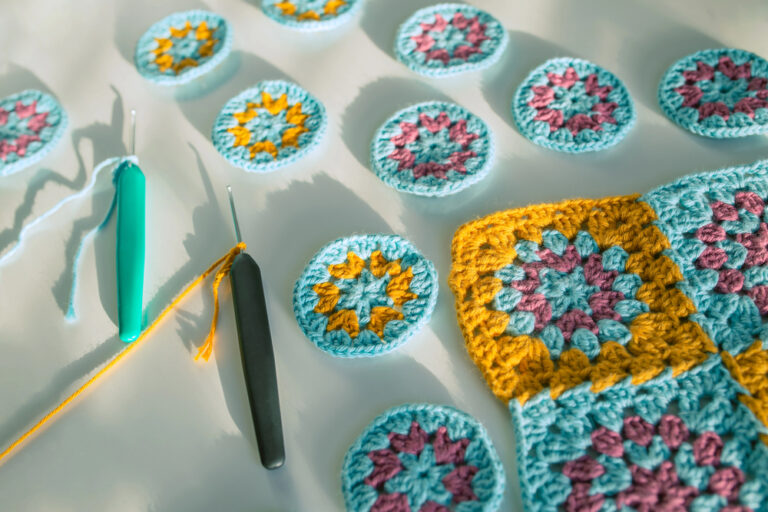
Introduction
The Tunisian crochet hook is a fascinating tool that bridges the gap between traditional crochet and knitting. It allows creators to weave textures that are denser than crochet but more flexible than knitting. For crafters seeking new textures, versatility, and artistry, mastering this unique hook opens up a world of creative possibilities. Whether you’re new to crocheting or a seasoned enthusiast, the Tunisian crochet hook provides a fresh way to enhance your crafting skills while expressing creativity through fabric and form.
1. Understanding the Tunisian Crochet Hook
The Tunisian crochet hook differs from the standard crochet hook in both design and technique. It is typically longer, allowing stitches to remain on the hook, similar to knitting needles. This design makes it ideal for creating large, textured fabrics without constantly turning your work. Some Tunisian crochet hooks even have cables attached to accommodate wider projects, like blankets or shawls.
Unlike regular crochet, where each stitch is completed before moving on, Tunisian crochet works in forward and return passes. This unique two-step process builds a more substantial fabric, blending the best of both knitting and crochet worlds. Understanding this structure is the foundation for mastering more complex techniques.
2. Mastering the Forward and Return Pass
The magic of the Tunisian crochet hook begins with its dual-action stitch formation. The forward pass involves picking up loops across the row, keeping them all on the hook. The return pass completes the row by working back through the loops, often using a yarn-over technique.
This rhythmic process gives Tunisian crochet its signature look—smooth vertical bars and a woven texture. It may take a few tries to adjust to the tension, but once mastered, the motion becomes fluid and meditative. Many crocheters find the repetition relaxing, as it produces visually pleasing patterns with minimal effort.
The forward and return pass also allow endless stitch variations, from simple to intricate. Whether it’s lacework or dense afghan stitches, understanding this fundamental rhythm is the key to crafting with confidence.
3. Exploring Popular Tunisian Crochet Stitches
The Tunisian crochet hook can create a wide variety of textures simply by altering how you insert the hook or wrap the yarn. Here are a few of the most popular stitches:
• Tunisian Simple Stitch (TSS): The foundation of all Tunisian crochet, this stitch produces a grid-like texture with vertical lines. It’s ideal for learning the technique and forms the base for most patterns.
• Tunisian Knit Stitch (TKS): Mimicking the appearance of knitted fabric, this stitch inserts the hook through the middle of the vertical bar, resulting in a smooth, knit-like surface.
• Tunisian Purl Stitch (TPS): By wrapping the yarn in front of the hook before pulling through, this stitch creates a soft, bumpy texture reminiscent of purl knitting.
• Tunisian Honeycomb Stitch: Alternating knit and purl stitches creates a delightful texture that looks intricate but is simple to execute once the basics are mastered.
• Tunisian Lace Stitch: Perfect for airy shawls or lightweight garments, this stitch introduces openwork patterns into your designs.
Each stitch pattern offers a unique look and feel, making the Tunisian crochet hook an essential tool for creative experimentation.
4. Benefits of Using a Tunisian Crochet Hook
The Tunisian crochet hook offers several advantages for modern crafters.
Texture and Versatility: One of its biggest appeals is the texture it produces. The resulting fabric combines the warmth of knitting with the structure of crochet. From soft scarves to durable home décor items, versatility defines this craft.
Creative Potential: Because stitches remain on the hook, complex designs become easier to control. You can integrate multiple colors or patterns within a single piece, giving your creations artistic depth.
Stability: The Tunisian crochet technique minimizes stretching, which is ideal for garments that need structure—such as sweaters or bags.
Therapeutic Flow: The repetitive motion of the forward and return passes promotes relaxation, helping many crafters reduce stress while staying focused.
Whether crafting for personal enjoyment or as a mindful practice, the Tunisian crochet hook supports both creativity and calm.
5. Common Mistakes and How to Avoid Them
Even experienced crocheters face challenges when transitioning to a Tunisian crochet hook. The good news is that most issues are easily resolved with practice and attention to detail.
Tension Problems: The most common mistake is pulling the yarn too tightly during the forward pass. This makes it difficult to insert the hook on the return pass. Keeping a consistent, gentle tension ensures even stitches and a smoother finish.
Curling Edges: Tunisian crochet fabric tends to curl due to the natural twist in the stitches. To reduce curling, use a larger hook than recommended, block your finished piece, or add a border using standard crochet stitches.
Uneven Edges: Beginners often forget to pick up the last vertical bar at the end of each row. Always remember to include it—it keeps your edges straight and professional-looking.
Neglecting Swatches: Since Tunisian crochet fabric behaves differently from standard crochet, making a gauge swatch is essential before starting larger projects. This ensures your piece will turn out the correct size.
By understanding and correcting these small errors early, you’ll develop consistency and confidence with your Tunisian crochet hook.
6. Creative Project Ideas to Try
Once you’ve mastered the basics, there’s no limit to what you can create. The Tunisian crochet hook is perfect for both small and large projects alike.
• Scarves and Shawls: These are ideal for practicing new stitches and color changes. The dense texture provides warmth and durability.
• Blankets and Afghans: Longer hooks or cable hooks make it easy to craft cozy, full-sized blankets that maintain shape and style.
• Pillow Covers: Add texture and artistry to home décor with Tunisian crochet pillow designs that feature geometric or floral patterns.
• Bags and Totes: The sturdy fabric created by Tunisian crochet makes for strong, stylish bags perfect for everyday use.
• Wall Hangings: Combine texture, color, and pattern for artistic home displays that highlight your craftsmanship.
Experimenting with patterns helps you understand how stitch combinations influence the overall look of your work. Each project deepens your skill and connection with the craft.
7. The Evolution of Tunisian Crochet
The Tunisian crochet hook has a fascinating history rooted in 19th-century Europe, where it was sometimes called “Afghan crochet.” Initially seen as a hybrid between knitting and crochet, it gained popularity for producing warm, decorative fabrics. Over time, its versatility and creative potential expanded worldwide.
Modern crafters now embrace it as an art form, using new materials, hook designs, and digital tutorials to explore complex stitch patterns. The Tunisian crochet hook has evolved into a tool for both tradition and innovation—blending heritage with modern design.
8. Tips for Choosing the Right Hook
Selecting the right Tunisian crochet hook depends on your project type and personal preference.
Length: Standard hooks are suitable for smaller projects, while long or cabled hooks handle larger pieces.
Material: Hooks come in wood, metal, plastic, or bamboo. Wooden hooks provide warmth and grip, while metal ones allow for faster movement.
Comfort: Look for ergonomic handles if you plan to crochet for extended periods. Comfort ensures better control and less hand fatigue.
Size: Using a hook one or two sizes larger than your yarn label suggests helps minimize fabric curling and maintain even tension.
Having a few variations allows you to experiment and find the perfect fit for your style.
9. Caring for Your Tunisian Crochet Hook
Proper care ensures your Tunisian crochet hook lasts for years. Always store it flat or upright to prevent bending. If you use wooden hooks, occasionally apply natural oil to maintain their smoothness. Avoid exposing hooks to moisture or extreme heat, which can warp or crack them.
When working with multiple projects, label or store your hooks by size and type for easy access. Consistent care guarantees that every creative session begins smoothly and efficiently.
10. The Joy of Creating with Tunisian Crochet
Learning to use the Tunisian crochet hook is more than a crafting skill—it’s a journey of self-expression. Each project reflects patience, rhythm, and artistry. The combination of motion and design fosters mindfulness, turning simple yarn into a tangible reflection of creativity and calm.
Whether you craft for yourself, as a gift, or for your home, the Tunisian crochet hook connects tradition with personal touch. As your skills grow, so does your appreciation for this timeless, versatile art form.
References
- https://www.craftyarncouncil.com/
- https://www.lionbrand.com/
- https://www.crochetguildofamerica.org/




